What could be better than a day at the beach! Surf fishing is a fun family beach activity to be enjoyed by all, at any time of year, and you don’t have to dig into your wallet to buy specialized gear. Bring whatever fishing tackle you have on hand. For Floridians, that’s likely to be a basic spinning outfit. Add a pyramid sinker, a hook with a leader and a bucket to cart home your catch. If you go more than once or twice, you’ll probably want to gear up a little more, but you don’t have to spend a lot of money — unless you really catch the fever. Can you think of a more relaxing way to spend your day?
You need a free* resident shoreline license, which can be obtained online from the Florida Fish and Wildlife Commission. No license is needed if you are under 16 or over 65 with an ID showing proof of age. Nonresidents must purchase a 3-day, 7-day or annual nonresident saltwater fishing license when saltwater fishing from the shore or a pier, bridge or jetty attached to the shore unless fishing on a pier with a pier license. The shoreline license does not apply when fishing offshore or when fishing on a remote beach reached by boat. *Free means that you pay nothing for the license, but you may have to pay a service fee. Note: If ordered by phone or online, be prepared to jot down your new license number, which you can use immediately to go fishing.
Gearing up
When you get to the beach, steer clear of swimmers, which could mean a short walk. I carry two 5-gallon buckets, one for my tackle (reels, sinkers, hooks, leaders, etc.) and the other contains a smaller bait bucket and a small cooler for drinks. Strap a beach chair to your back for the short hike away from swimmers. (Swimmers scare fish.)Keep nail clippers in your pocket for clipping line.The Bucket – A basic 5-gallon bucket is ideal. Bucket inserts, available at home improvement stores, make fine compartments for your tackle. Bait Bucket and Aerator – For the second 5-gallon bucket, buy a perforated lid from any bait shop to keep live bait contained, and use a portable, battery-powered aerator to keep the water oxygenated. Talk to the bait shop clerk about the best live bait to use in the area you’re going to fish. He’ll have it, or you can catch your own. Rod Holders – Rod holders keep your rod and reels out of the sand. You can buy them, but it’s easy to make them yourself out of a three-foot length of PVC pipe. Use a hacksaw to cut a point at one end for driving into the sand. I pack a rubber mallet to pound it into the sand. The Beach Cart — Many regulars go for all the bells and whistles, including PVC-framed carts for carrying gear. You can purchase these hand-made carts at many beach-area bait and tackle shops for $150-$200, or you can build one yourself to meet your specific needs. The key to building a successful cart is the beach wheel, which needs to be wide and roll freely. Here are a few ideas from FloridaGoFishing.com. Fish Ruler — Invest a couple of dollars in a fish ruler and a fish ID card. This is not about getting caught, it’s about preserving the fishery for the next time you fish by respecting length and limits. You can buy a fish ruler at any bait shop, or you can buy a ruler sticker for your cooler from Florida Sportsman magazine for $6.99. I would also recommend carrying a Fish ID Card in your tackle box, such as this one on Amazon for $7.99. Both the ruler and the card reflect the most recent Florida size and catch limits, and both are invaluable.
Rods and Reels
A basic medium spinning outfit will suffice, but you might want to consider this: The Rod – Most agree that a sturdy rod about 10 feet is the best choice for casting in the surf beyond the break line. I carry an 11-foot Harnell, the granddaddy of surf rods, and an inexpensive 9-foot White Rhino, which is suitable for most conditions. Whatever you use, a longer butt is best for casting. The Reel – The “pros” use a wide, free-wheeling baitcaster, but unless you know how to use it, leave it on the shelf. Backlash is a nightmare. Choose instead a decent medium-weight spinning reel that can handle a few hundred yards of 25-lb to 30-lb. line. I usually carry three spinning reels, wrapped in clean rags, and carry them out in my tackle bucket to keep the sand out. Tools – Bait knife, long-nose pliers, gloves and nail clippers. You need pliers to remove hooks from your fish without hurting the fish, and nail clippers are indispensable. I rarely use a bait knife because I fish most often with live bait. Gloves are useful for holding your catch and protecting your hands from sharp teeth and fins. Special casting gloves without fingertips can be purchased, as can mesh fishing gloves, but vinyl gloves do the least damage to your fish. Don’t discard vinyl gloves on the beach or in the ocean. Re-use them.AD Kick it up a notch with 9′ Penn surf fishing outfit (rod reel combo) $120 on Amazon.
Tackle
The Line – Monofilament line is the choice of most surf anglers, but old-school fishers use braided lines. Today’s braided lines are thinner and stronger. One of the three reels I bring to the beach has 150 yards of 30-lb. braided line with a monofilament backing of another 200 yards. This allows room for the fish to run and wear itself out. My other two reels have monofilament, 15-lb. and 25-lb. test. Sinkers – Pyramid sinkers creep into the sand and hold your bait near the bottom. They come in various sizes, and it’s a good idea to bring a selection for varying surf conditions. Some have wire anchors, although they can be troublesome. Egg sinkers and bucktail jigs work, too. A little bounce on the bottom stirs up the sand, attracting fish. In a calm surf, let your bait swim on a line unencumbered by a weight. Hooks – Many swear by circle hooks because the set quickly, but the standard J-hook works best for me. You’ll need to pay closer attention to the J-hook, but that’s fishing, right? Basic Rigs – The basic rig for most saltwater fishing is called the Fishfinder, or sliding rig. Slip the tag end of your line through the eye of your sinker, then attach a swivel big enough to stop the slide. On the other end of the swivel, attach a 30-lb. leader with your hook. Add bait and go fishing. Special rigs – The possibilities here are endless, but the one I use most is called a “pompano rig.” Don’t bother making one, just buy a ready-rig at your bait shop. They are available everywhere. The pompano rig has two or three sub-leaders, spaced and tied off on the main leader, with small circle hooks. Clip a pyramid sinker to a swivel at the bottom of the rig. Simple to use and effective in the surf, especially for pompano. Lures and Jigs – Other than jigs, lures are not always effective in the surf, except when the mullet are running. You might try an imitation mullet, but live bait is always best and bait shops usually have plenty of live mullet in season. At other times, try a live shrimp on a jig, then bounce it on the bottom a few times in the surf. The jig of choice for surf fishing is the feathered bucktail jig tipped with a small piece of shrimp. This is also an effective lure for inshore waters, such as the Indian River Lagoon. Nets – Not required, but it may help. As you reel your catch to shore, fish bounce in the surf and get thrown off your hook. Walking out to meet the fish with your net gives you an edge.You can find interesting fishing tips and reviews of gear at Fishingkris, an informative blog written by Kristian Rørbye.
Bait
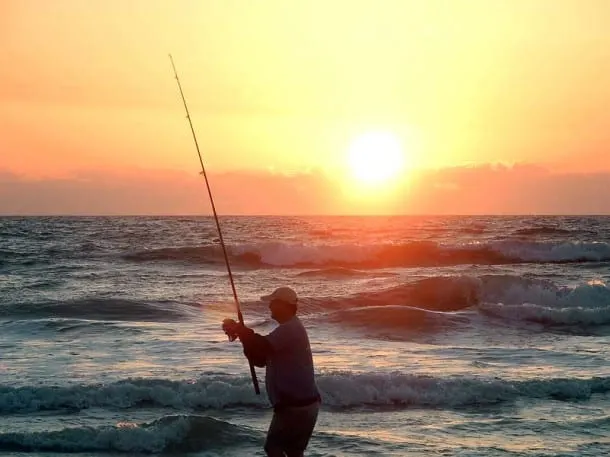 Mullet — Best during the fall mullet run. Hook just in front of the tail or through the nose. If the surf is calm, let the mullet run free in mild currents. In rougher surf, you may want to use a sinker.
Sand fleas – Not really a flea, but a small crab. Premium bait for pompano, a delicious white-flesh fish and prime game in Florida’s Atlantic coastal waters. Also known as a mole crab, you can either buy them at a beach-area bait shop or pick them out of the sand along the surf line. As the surf rolls back, watch for tiny disruptions in the outward flow, showing as a V. Those are antennae. Scoop the sand around the crab and dig them out.
Shrimp – Live is best, but frozen works in a pinch, just not as well. Frozen shrimp tears apart in surf, leaving little as bait. With live shrimp, you need a bucket and an aerator to keep them alive for a day of fishing. The aerators run on batteries and attach to your bucket. Add seawater, drop the tube with an aerator head into the water to continually adding oxygen. Without an aerator, the shrimp won’t last long. You can buy an aerator for under $20.
Squid – Readily available frozen. Cut the body into thin strips and use one at a time on each hook or jig. I don’t have much luck with squid, but many folks do, so it’s worth considering, especially if no other bait is available.
Mullet — Best during the fall mullet run. Hook just in front of the tail or through the nose. If the surf is calm, let the mullet run free in mild currents. In rougher surf, you may want to use a sinker.
Sand fleas – Not really a flea, but a small crab. Premium bait for pompano, a delicious white-flesh fish and prime game in Florida’s Atlantic coastal waters. Also known as a mole crab, you can either buy them at a beach-area bait shop or pick them out of the sand along the surf line. As the surf rolls back, watch for tiny disruptions in the outward flow, showing as a V. Those are antennae. Scoop the sand around the crab and dig them out.
Shrimp – Live is best, but frozen works in a pinch, just not as well. Frozen shrimp tears apart in surf, leaving little as bait. With live shrimp, you need a bucket and an aerator to keep them alive for a day of fishing. The aerators run on batteries and attach to your bucket. Add seawater, drop the tube with an aerator head into the water to continually adding oxygen. Without an aerator, the shrimp won’t last long. You can buy an aerator for under $20.
Squid – Readily available frozen. Cut the body into thin strips and use one at a time on each hook or jig. I don’t have much luck with squid, but many folks do, so it’s worth considering, especially if no other bait is available.
The Florida Fishing Bible: Vic Dunaway’s “Complete Book of Baits, Rigs and Tackle” published by Florida Sportsman is a must-have guide for any angler, novice or pro. Buy it direct from Florida Sportsman for $17.99. (Not paid advertising.)
A note about the value of local bait shops…
Patronize a bait shop near the beach you want to fish. These guys know what’s biting and what kind of bait you should use. Of course, their advice is not infallible, but they know better than anybody except the guy who fishes that beach every day. The bait shop clerks will also be happy to advise you on your tackle for fishing locally and the rigs you’ll need for best results.Where, when and how to fish the surf
Most beaches in Florida allow surf fishing, unless there are large crowds of swimmers. In some cases, restrictions limit hours for fishing. Usually, those permissible fishing hours are early morning and near dusk, which are the best times to fish, anyway. Beaches with restrictions will post the rules as you enter the beach. You don’t want to be near swimmers, anyway. Wear water shoes or beach sandals to protect your feet from rocks, coral or shells below the surf. Bring a hat and good sunscreen. Start early or late – Fish are rummaging for food as the light starts to come up, before dawn, so you want to be there to feed them your bait. Don’t despair if you arrive late, especially during the fall mullet run. At some beaches, anglers report better fishing as the day wears on. Another popular time to fish is at dusk, when the water begins to cool and fish come off the bottom to hunt for food. Tide can also be a factor at midday.Florida has more than 600 miles of beaches and 1300 miles of coastlineCheck reef structure and tidal flow – If there are reefs or sandbars near shore, as there are on Hutchinson Island and Canaveral National Seashore, watch the ebb and flow of currents. Fish are often trapped in the trough between the beach and sandbars or a reef on an outgoing tide, but they flow out through gaps. You can see the outward flow on the surface, and it’s productive to position yourself to fish the outflow. When you cast, don’t be afraid to get wet. Fishing the troughs near beach may not require a long cast, but if you don’t have such structure, you’ll need to cast as far as possible. That’s where a longer rod is a big plus. Wade into the surf as far as comfortable and take your time casting. A steady, progressively faster cast with a release at 1 o’clock will give you the most distance. It takes practice. Catch and release – Decide ahead of time whether you plan to release your catch. My rule is that if I’m not going to eat it or use it for bait, the fish goes back in the sea. When you land the fish, pick it up carefully but firmly and remove the hook. Wet your hands first so that you don’t remove the slime that protects the fish, or use vinyl gloves. Once the hook is removed, carry it into the surf and gently release it in the water. DON’T THROW IT! Throwing the fish into the ocean is for amateurs. Watch out for barbs, teeth and sharp fins. If the fish doesn’t move, give it a nudge so the water will flow through its gills.
Everybody has a different way of doing things, so I encourage your comments, questions, tips, techniques and tricks for surf fishing in the comments below.

Bob Rountree is a beach bum, angler and camper who has explored Florida for decades. No adventure is complete without a scenic paddle trail or unpaved road to nowhere. Bob co-founded FloridaRambler.com with fellow journalist Bonnie Gross 14 years ago.


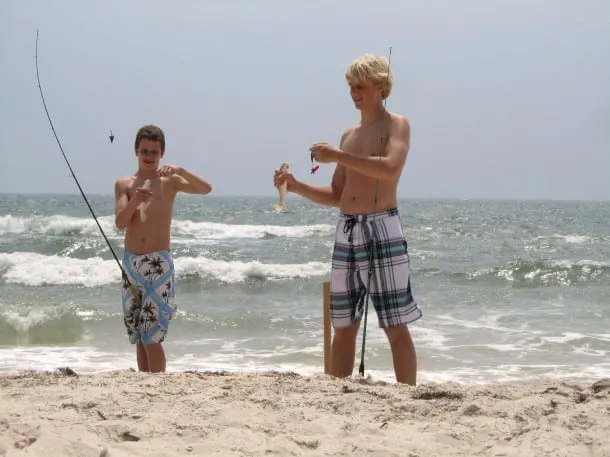
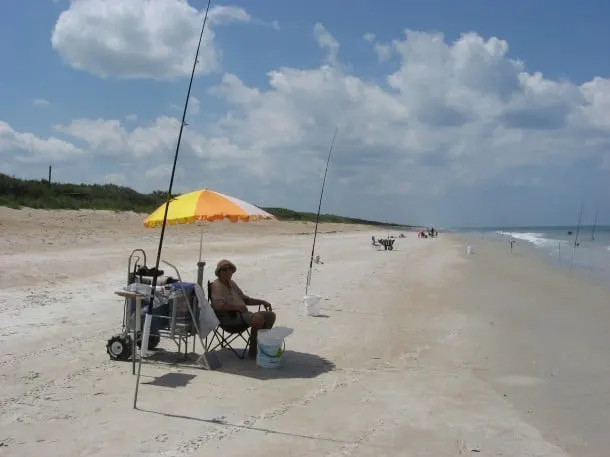
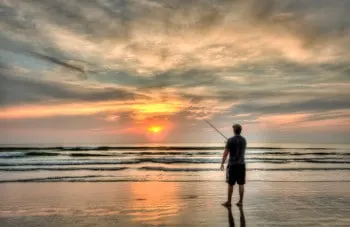
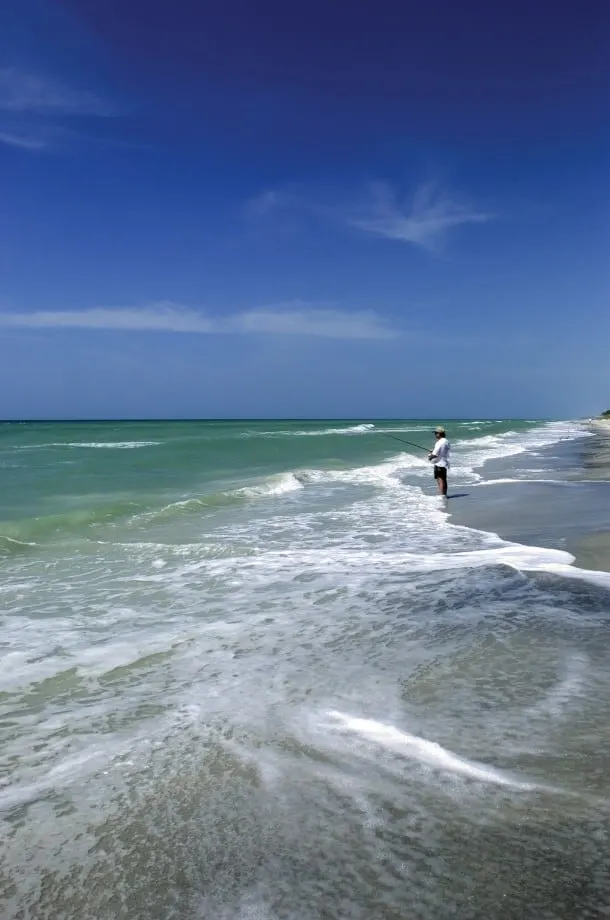
Nico
Thursday 12th of January 2023
Thanks for the information. I´m staying for a month in Pompano Beach next May and would love to know which beaches close to this area I can fish at without time restrictions... as I´m going with my family it would be great to be able to spend the day with them at the beach and be able to fish at the same time. Can you point me to the right place?
Bob Rountree
Thursday 12th of January 2023
I would suggest going to the NE 16th Street Beach (North Ocean Park) in Pompano and walking north towards the jetty, away from the kite surfers and other beachgoers. The beach is protected from a rock ledge offshore, which corals fish on the outgoing tide. Your best catch, though, will be from atop the jetty itself on either an incoming or outgoing tide. This area is great for families, but you need to get there early for parking. If there are no parking spots left, you'll either have to hang out until somebody leaves or find a spot on a side street across A1A. If that doesn't work out, fish from the pier, which is 14 blocks south of 16th street towards Atlantic Blvd., where there's plenty of parking in the garage and a playground for kids. Enjoy!
R J
Wednesday 4th of January 2023
Great post with wonderful information for the surf fisher,thanks.